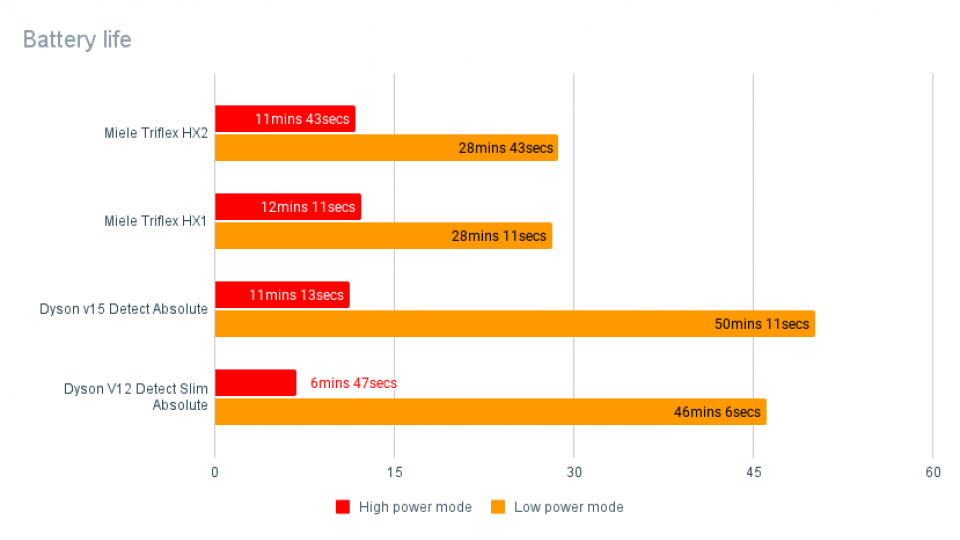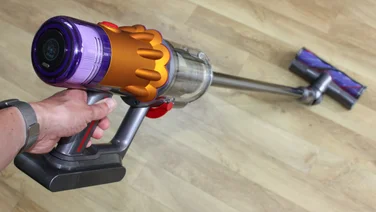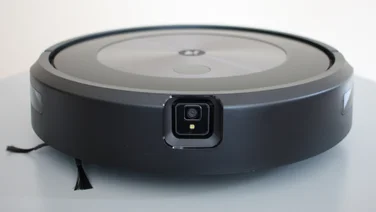To help us provide you with free impartial advice, we may earn a commission if you buy through links on our site. Learn more














- Adaptable
- Stands upright
- Good at most cleaning tasks
- Expensive
- Fiddly to switch rollers
- Lacks anti-tangle
At first glance, the Miele Triflex HX2 Pro looks a lot like the Miele Triflex HX1 (£480). However, Miele is claiming the HX2 has 60% more power than its predecessor.
For the uninitiated, the Triflex in the name is a reference to its three modes of operation. Like most cordless sticks, you can arrange it as a simple handheld device for tackling stairs, furniture and cars. Alternatively, you can clip on the extension wand and the motorised floorhead and you’ve got a standard stick vacuum, with the main unit up at the handle.
However, there’s also a third way. By clipping the vacuum unit straight into the floor head, removing the handle and replacing it with the extension wand, then attaching the handle back onto the far end of the wand, you’ve got something that looks more like a cordless upright.
In this configuration, it even stands up and balances without requiring further support, so you don’t have to find something to lean it against, a trick we haven’t seen in a cordless stick vacuum since reviewing the AEG QX9 (£300).
Miele Triflex HX2 Pro review: What do you get for the money?
As you might expect from its name, the Miele Triflex HX2 Pro is a top of the range model. However, they’re all expensive: the basic HX2 costs £599; there’s a mid-range model (the HX2 Cat & Dog) that costs £589; then the Pro is £849. The actual vacuum unit is the same in all three models, with the increase in price factored around what else comes in the box.
The standard model comes with the main motorised floor head, which doesn’t include a light, and has a core collection of three attachments: the usual crevice tool, dusting brush and upholstery nozzle. It also comes with a dock you can use to hold the vacuum against a wall when it’s not in use or needs charging.














Opt for the Cat & Dog configuration and you get the same attachments as the base version and an alternate floor head that has a light, making it easier to see what you’re doing when vacuuming under furniture and in dark corners. This model also comes with a miniature motorised head, which is useful for removing stubborn pet hair from furniture and tackling smaller areas, such as stairs.
The Pro version, reviewed here, comes with the basic attachments and the illuminated floor head, but doesn’t have the mini motorised tool. However, it does come with a second battery, a separate battery charger, and two extra rollers that you can swap out for the standard brush roller in the main floor head. These are a secondary, softer carpet brush roller for delicate carpets, and a soft roller for hard floor.
If you’d rather create your own mix and match, most of these extras are available to purchase individually through Miele’s website.
The vacuum cleaner itself measures 1,297 x 280 x 260mm (H x W x D) and weighs 3.6kg when all the pieces are connected together. The collection bin has a capacity of 500ml, which is a little on the small side. And it looks like it will fill rapidly, too, with carpet fluff collecting and jamming at one side during our tests.
READ NEXT: Our full round-up of the best vacuum cleaners you can buy
Miele Triflex HX2 Pro review: What’s it like to use?
The best thing about the Miele Triflex HX2 Pro is its configuration options. I enjoyed using it in its upright-like mode, which kept much of the weight of the vacuum near the floor and made it easy to push around. This is the configuration in which you can leave the vacuum upright without leaning it against anything, which is a major boon.














The downside of this arrangement is that it’s more fiddly to convert into a handheld device, because you have to disconnect and rearrange every part. If you keep it in cordless stick mode instead, you have the handle in the right place and can simply disconnect the extension wand and it’s ready to go. You also can’t really see the battery light indicator while you’re vacuuming, unless you lean the stick right back specifically to have a look.
The vacuuming unit is a significant weight at 2.08kg, so it’s reasonably weighty when used as a cordless stick or a handheld. Most people shouldn’t have a problem in short bursts, but using the vacuum in either mode for extended periods might be tiring if you don’t have particularly strong arms.
There’s only one control on the device: a four-point sliding switch that’s located on the handle, about where your thumb lies as you hold it. You choose between the four states (Off, Min, Eco or Max) by pushing the slider towards the floor head. It’s fairly simple to flick it to each step but a bit fiddly to go straight to Eco, for example, because you have to remember to make two clicks, and it tends to head straight to Max with very little force applied. Considering Eco is likely to be the mode of choice, it’s slightly cumbersome.
To release the collection bin you have to twist the lid, which unlocks it from the main device. Take it to your bin and twist the lid further, in the same direction. This releases the base, which opens on a hinge and should deposit the contents into the dustbin, though I found it needed a bit of a poke to pull everything out. It’s a bit messy but not particularly unusual in a bottom-emptying bin, which rarely empty as neatly as they ought to.














The Pro version comes with a soft floor roller you can insert into the floor head instead of the carpet brush. This is a welcome addition but it’s more fiddly than Dyson’s entire head swap, requiring you to unlock the side panel, slide it back to expose the end of the brush, pull that through the hole, then line up the replacement brush before locking it all back up again. It would have been good to get a second floor head with this already built-in, to make this process a little smoother. Shark does it even better, building both soft roller and brush roller into one universal floor head.
While on the subject of the rollers, I was disappointed none of them offer any kind anti-tangle mechanism to keep the roller free of hair. If you live with long-haired people or pets, you’re going to end up getting the scissors out to regularly clean the roller on this vacuum cleaner. On such an expensive device, it’s a major disappointment.
Miele Triflex HX2 Pro review: How well does it clean?
The Pro version of the vacuum is amongst the most expensive cordless sticks you can buy at the moment, so it makes sense to compare it to the top-of-the-range Dyson V15 Detect (£530), which looks positively affordable next to the Miele.

As you can see from the suction graph below, the HX2 is significantly less powerful than Dyson’s, with even the cheaper V12 Detect Slim (£429) outsucking Miele’s vacuum. Raw suction power isn’t the only metric we judge a vacuum cleaner on but it’s an interesting starting point, with Dyson’s cordless sticks taking the lead from the off. However, it’s worth noting that the HX2 is notably better in this regard than its predecessor.Next, we tested the Miele Triflex HX2 with our usual barrage of tests, spilling flour and Cheerios onto both hard floor and carpet, and measuring precisely how much the unit picked up on a single pass.
In the flour test we started on a short-pile carpet. With 50g of flour deposited, a single pass of the vacuum with the brush roller installed collected 44g. A visible dusting remained behind but subsequent passes collected another 4g and left nothing behind that we could spot with the naked eye.
On hard floor I swapped the brush for the soft roller and it performed even better, picking up 49g of 50g. To my eye there was nothing visible left behind, it did an excellent job.
Moving on to Cheerios, I didn’t have particularly high hopes. The front of the floor head has a lip that almost touches the floor, and while there’s a slight angle to it, which raises the front slightly, it didn’t look like it was going to deal with chunky Cheerios particles.
On carpet I was pleasantly surprised, though. After initially looking like it was going to snowplough the Cheerios ahead of it, I set the suction to Max and it proved powerful enough to drag the Cheerios underneath. Once it had climbed the vanguard, the rest didn’t have much of a chance, and it collected 25g of a 26g spill in one go.
However, my fears were justified on hard floor, where there just wasn’t enough traction to lift the head onto the first row of Cheerios, and it simply pushed them ahead. Changing roller didn’t make a jot of difference. Unfortunately, that means it failed the test. However, by dismantling the vacuum and switching to handheld mode, with nothing attached to the suction inlet, the Cheerios raced into the collection bin. It does the job but you have to get down onto your hands and knees.














Dyson and Shark’s soft rollers do the job much better. They don’t have a plastic guard than goes down to the floor on the front of the floor head, which lets the fluff on the roller create the seal the vacuum needs to pick things up and provides enough space for larger items such as Cheerios to pass underneath.
READ NEXT: Our guide to picking to best Dyson vacuum for your needs


As you can see from the chart below, the upshot of this is that the Miele isn’t as strong as Dyson at picking up spills. It performs better if you ignore the Cheerio failure (which is an arguably legitimate option, since it can still pick them up in handheld mode) but it still falls short of Dyson in our tests.Finally, I was impressed with the 11 mins 43 secs I got out of the HX2’s battery on full power; it falls slightly behind the performance of the HX1 in this regard but by less than 30 seconds. However, it only lasted 28mins 43secs on its lowest power setting. With the Pro model tested here you get two batteries so you there’s get enough power in the box to double both scores, but you need to have both fully charged and perform a half-time battery swap to get it.
Miele Triflex HX2 Pro review: Should I buy it?
There’s a lot to like about the Miele Triflex HX2 range, and the HX2 Pro in particular. I enjoyed the option of reconfiguring the vacuum in a different way, and it’s always a joy to find a cordless stick vacuum that can support itself in an upright position when not in use.
However, with the HX2 range costing between £599 and £849, what you’d fully expect absolute perfection. Unfortunately, it falls down here, with too many missing features and a soft roller that doesn’t work as well as it should.
The absence of an anti-tangle system feels like a significant let down compared to rivals, and having to switch rollers in the one floor head is clunky. The collection bin doesn’t quite hit the capacity sweetspot, and the simple switch control is brutally mechanical compared to the slick digital controls you’ll find on cheaper rivals.
If have got this kind of budget to spend on a vacuum I recommend you pick up the Dyson V15 Detect (£530) instead. Most of the V15’s features are a step up from what you get with the Miele and – scarcely believably – the Dyson is the cheaper machine. If you want to save a bit of money, particularly if you have a smaller space to clean, the Dyson V12 Detect Slim (£429) is a smaller alternative that maintains the same high standards.
For a cordless stick that doesn’t need the floor head or roller changing when moving from carpet to hard floor, consider the Shark IZ300UKT (£400). It’s cheaper and less classy than Miele and Dyson’s cleaners but punches well above its weight in terms of cleaning ability and clever features.






